NASA Stunned by Unusual Behaviour of Asteroid Dimorphos
NASA successfully altered the orbit of an asteroid named Dimorphos by crashing a spacecraft into it as part of the DART mission. However, the asteroid’s behavior has become peculiar, capturing the attention of astronomers and even high school students. Surprisingly, these students made an unexpected finding while studying NASA’s DART mission in the Didymos System. It is worth noting that Dimorphos is one of two asteroids in a double asteroid system, with the larger one being called Didymos, around which Dimorphos orbits.
Special orbital changes
At first, after the accident, NASA believed everything was fine, but a high school teacher named Jonathan Swift and his students disagreed. They noticed that Dimorphos did not behave as expected after the crash, TOI reported.
Dimorphos, after the collision, began to rotate strangely while maintaining its regular path around its parent asteroid. Instead of accelerating, its orbit shrank, which astronomers found quite unusual.
Different observations
Swift and his students used a telescope to track Dimorpho and found that its rotation rate had slowed by 33 minutes several weeks after the impact. This deceleration continued at a rate of 1 minute per episode. However, their calculations did not exactly match NASA’s observations, showing a 34-minute slowdown.
Jonathan Swift said: “Our number was a bit different, a 34-minute change. It was confusing.”
DART’s mission
NASA’s DART team confirmed that Dimorphos did indeed slow down after impact, but they only counted 15 seconds, not a full minute. This slowdown leveled off over time.
To understand this strange behavior, it seems that Dimorphos slowed down due to the collision. Some of its pieces scattered in its path, causing it to slow down as it passed through them again and again. After about a month, when it had passed all these obstacles, it continued its regular motion without changing its speed, reaching a state of equilibrium.
In 2026, the European Space Agency’s spacecraft “Hera” will arrive at Dimorphos, which could provide more insights into this phenomenon.
The DART mission was designed to test NASA’s ability to alter the path of an asteroid and demonstrate its ability to protect Earth from potential asteroid threats. By bumping into Dimorphos, it gave us valuable information about how asteroids can be rotated, helping to understand celestial objects. If it succeeds, it will be an example of global cooperation in the defense of the planet and ensure the safety of our planet from possible asteroid collisions.
This isn’t the first time NASA’s DART mission has had unexpected results, but the collision with Dimorphos has revealed new discoveries that shed light on previously unknown aspects of the mission’s impact.




